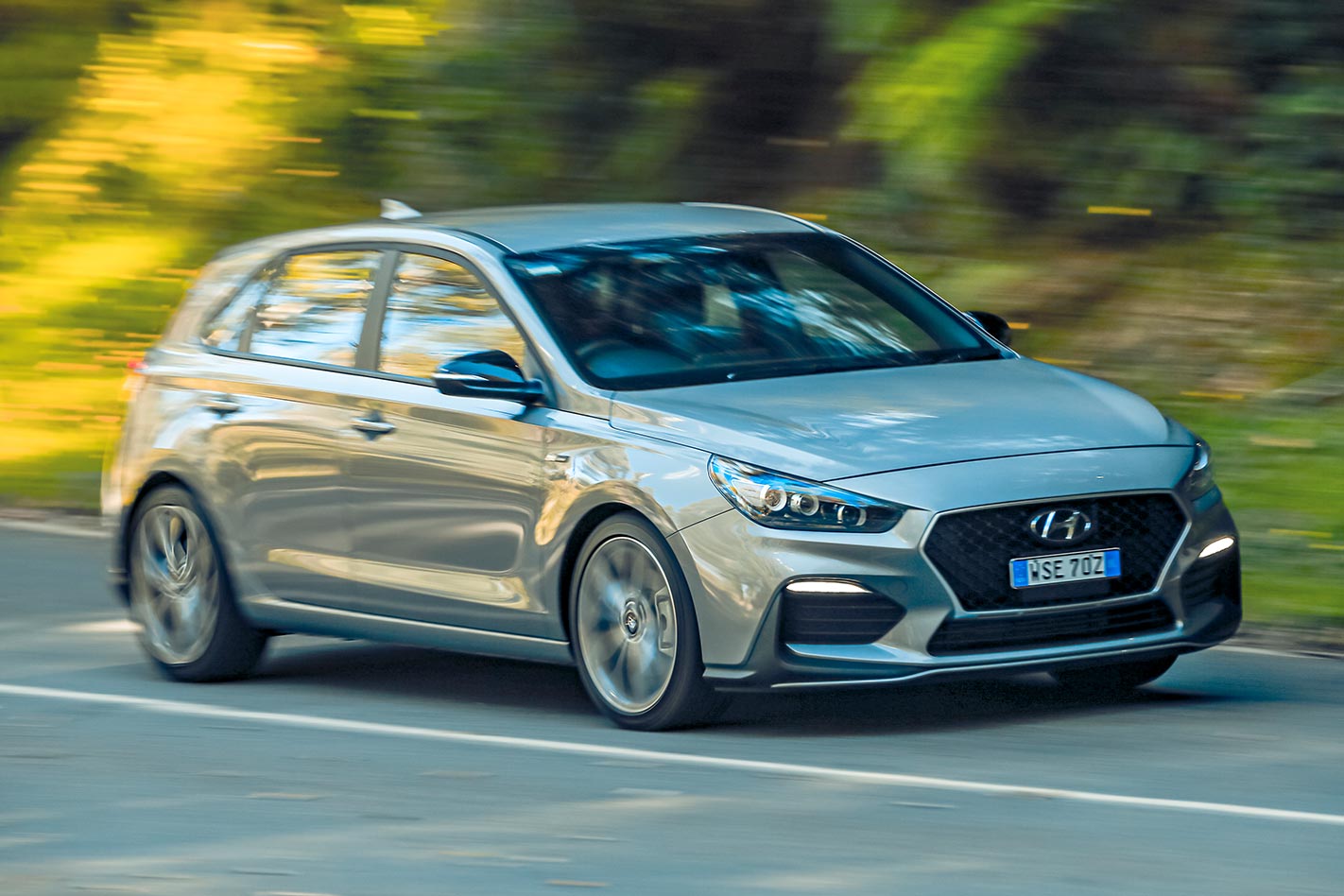Things we like
- Entertaining dynamics
- Space and convenience
- Value
Not so much
- Interior becoming dated
- Ride on the stiffer side
- No facelift for N Line
Hyundai’s made it very clear in recent years that it’s not afraid to get a little sporty. Most obviously, the Hyundai i30 N made waves with cracking dynamics at an affordable entry price, shaking up the established hot hatch hierarchy.
But what if you want to dip your toe in without firing off a slew of WRC-inspired exhaust crackles at your neighbours every morning? What if the N’s ride is a bit firm, or if its price is perhaps a bit much? The Hyundai i30 N Line is likely where you should start your new car shopping list.
Largely an update of what used to be called the i30 SR, the N Line is… well, effectively an N Lite. The Hyundai i30 N Line lacks a majority of the aggression of the full-blown N both on and under the surface, but the N Line does score some of its gym-junkie brother’s strengths.
Firstly, the N Line is a similarly positioned value option when compared to its rivals. Much like the N when compared to the likes of the Golf GTI and Honda Civic Type R, the Hyundai i30 N Line takes some of the performance and styling from the N department, run by former BMW M boss Albert Biermann, and brings it to a hatchback that can compete with the likes of the more comfort-oriented Mazda 3 or Toyota Corolla.
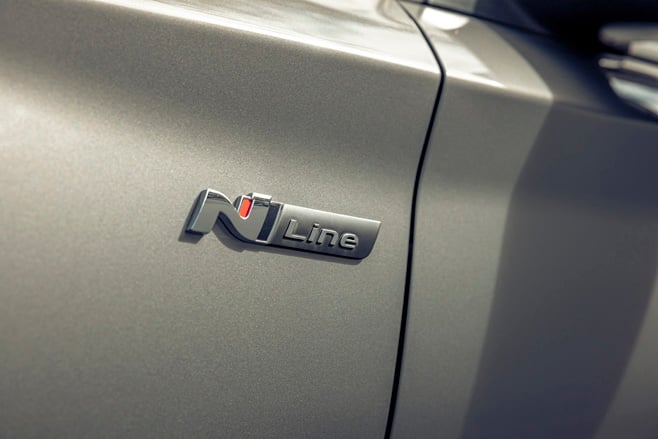
For a start, the i30 N Line’s pricing is quite attractive. At $31,420 before on-roads and options, the Hyundai undercuts the top-spec Corolla ZR by more than $1000 and comes with a more powerful turbocharged 1.6-litre engine, coupled to a seven-speed dual-clutch gearbox. A Premium variant is also available with an up-specced interior for $36,220.
Hyundai offers a free initial service after one month or 1500km and i30 N Line buyers can opt into a five-year servicing plan that covers up to 75,000km for $1385 upfront. Of course, Hyundai’s standard five-year unlimited-kilometre warranty applies.
Even with statutory charges and delivery fees that come to just under $4000 using Melbourne as an example, the driveaway price with premium paint (our test car wears fluid metal) sits at $35,854. Its 150kW/265Nm outputs have similarly priced rivals outgunned and it’s available with a cheaper 6-speed manual gearbox if the DCT isn’t your thing.
Its styling, too, has hints of N, from the black plastic trim and darker headlight surrounds, to the faux diffuser at the rear flanked by twin exhaust exits. On the road, it very much presents as a mid-point between a less performance-focused i30 and the wicked-looking N. Unfortunately, while the lower variants in the i30 range were treated to the MY21 package in Australia, supply issues mean the i30 N Line doesn’t benefit from the exterior update, instead receiving only the interior upgrades.
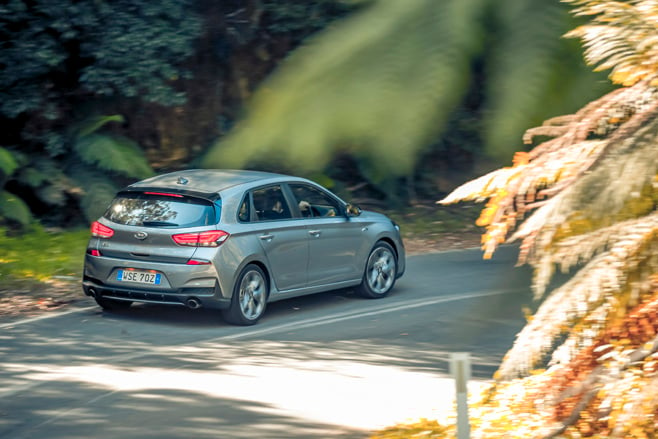
On that, the i30 N Line is a comfortable and well laid-out place to be inside, if a little familiar given not much has fundamentally changed since the days of the i30 SR a few years ago. N Line does mean more sporting zing inside though, with red stitching on the leather-like seats and gear lever joined by red accents around the air vents and extra lining on the front seat bolsters. Seatbelts, too, are red.
While the space around the driver isn’t exactly luxurious, it’s far from lacking in comfort or convenience. The leather-wrapped wheel is a nice touch, literally, and the leather-appointed driver’s front seats are able to be moved into an ideal driving (or passenger) position, with the seat bolstering providing a nice balance between comfort and firmness.
Some of the hard plastics around the cabin don’t feel particularly pleasant, but regular touchpoints in the car are all well-placed and comfortable.
The infotainment screen is an 8.0-inch unit, though a 10.25-inch version is found in the N Line Premium, augmented with smartphone mirroring via either Apple CarPlay or Android Auto. Apple CarPlay can be used wirelessly in the i30 N Line, though an iPhone-owning colleague pointed out that while it’s easy to set up it is prone to dropping out – though this is not a problem specific to Hyundai.
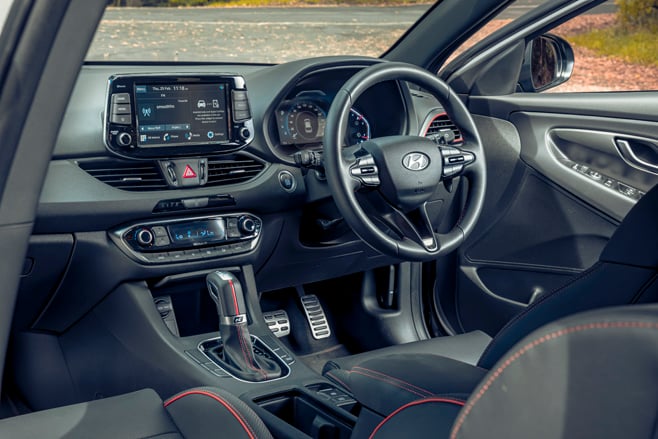
Storage for bottles and drinks is well-catered for, with the usual cupholders supplemented by spacious storage in each door ‘bin’, but the centre console’s storage is about the size of a couple of drink cans and not particularly wide. There’s a 12V plug in there, too, but the one found under the HVAC controls alongside the USB plug is more continent. The glovebox is better for space albeit harder to access for the driver.
Ultimately, most storage will likely be bags tossed into back seats, or more sizable luggage and cargo hauled in the i30’s generous 395-litre boot. Of course, rear 40/60 split seats can be lowered to get larger cargo in, as long as the seat isn’t occupied by anyone enjoying the relatively spacious yet basic rear pew.
For safety, the i30 range gets five stars from ANCAP, even upon its testing in 2017 when it was hurled at the wall sans-AEB. Passenger protection in crashes is of course completely sound, with front airbags for driver and passenger, a knee airbag for the driver, side airbags for both front occupants, and curtain airbags front and rear.
The i30 also now benefits from the Hyundai SmartSense suite of active safety tech, including the previously absent automatic emergency braking, which Hyundai confusingly calls Forward Collision-Avoidance Assist (FCA; not to be confused with Fiat Chrysler Automobiles). Also included is lane-keeping and follow assist, a driver attention monitor and warning, plus rear cross-traffic alert and blind-spot monitoring. It also has front and rear parking sensors with distance guidance to assist the rear parking camera.
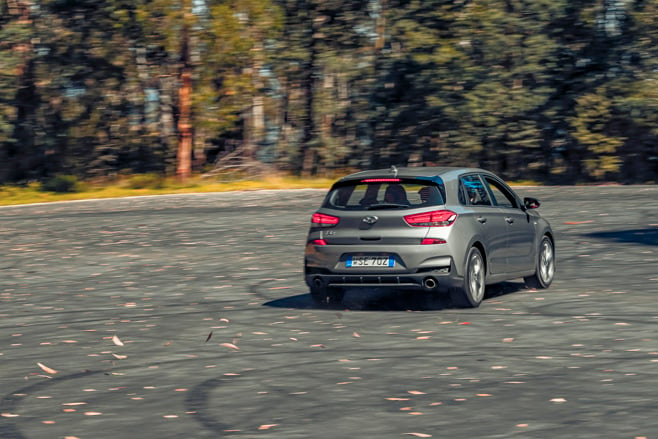
While the list of active safety features can sometimes sound like it all gets in the way of actually driving the car, that’s fortunately not the case in the i30 N Line. And driving the N Line is something you’ll actually want to focus on, not because it’s a challenge, but because it’s really quite enjoyable.
While it’s immediately noticeable upon taking off that the i30 N Line has a stiffer suspension tune than other hatchbacks in the segment, and its initial turbo lag can feel a little old-school, this hatch is a pretty capable performer. Daily driving duties in its standard driving mode won’t bring out any lairy characteristics of the i30 N Line though as it can be a very docile thing when needed.
Its suspension, while firm, is comfortable enough over bumps and keeps the driver in control if things go awry, even at higher speeds, while the steering is similar. Firm, but precise. Into Sport mode, and the fixed suspension remains the same while the steering feel gets weightier, perhaps a little much so. It’s unnecessary for regular driving but allows you to make use of the N Line’s generous 150kW, aided by a rewarding and sprightly DCT gearbox. Paddle shifters help keep things moving along, with the DCT swapping cogs rather obediently.
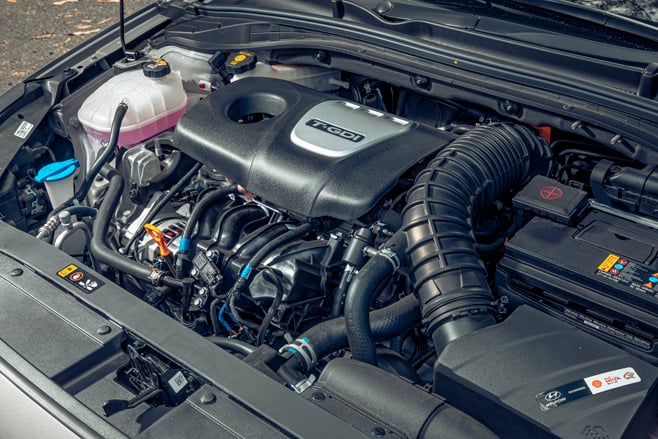
It’s a car that can surprise, given its initially somewhat tame character, with how quickly it can get along on a winding road. Michelin Pilot Sport 4 tyres help keep the N Line in check, too, but if grip begins lacking, the lightening of steering and chassis movements are quick to let the driver know well before grip disappears.
Highway driving, too, benefits from the combination of this engine and gearbox at cruising speeds, though there’s a little more road noise through the tyres and suspension than we expect most would like on a long trip. Fortunately, its tied-down nature and 305mm front brakes prove excellent at keeping stable under high-speed braking.

Ultimately, the Hyundai i30 N Line provides a fine balance between convenience and character, where the dynamics of the car don’t diminish its ability to haul luggage on a holiday or provide a comfortable space in which to commute. On top of that, the price provides plenty of bang for buck and the i30 N Line range itself even provides opportunities to save or spend more, depending on your preferences.
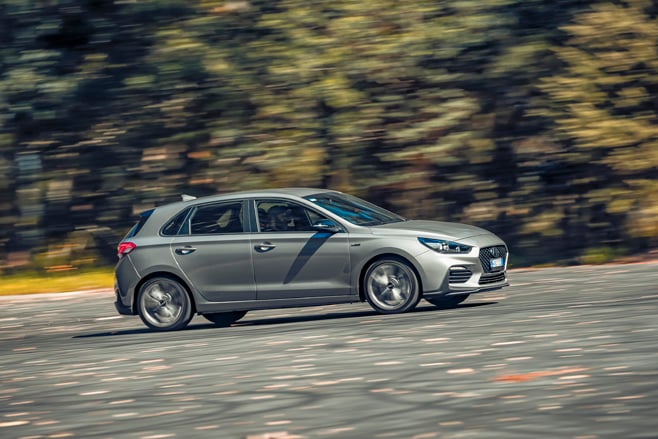
2021 Hyundai i30 N Line specifications
Body: five-door, five seat hatch Drive: front Engine: 1591cc inline-4, DOHC, 16v, turbo Bore/stroke: 75.6mm x 89.0mm Compression: 10:1 Power: 150kW @ 6000rpm Torque: 265Nm @ 1500-4500rpm Fuel consumption: 7.1L/100km Weight: 1344kg (up to 1436kg) Power/weight: 112kW/tonne Transmission: 7-speed dual-clutch Suspension: Strut, damper, spring, anti-roll bar (f); Multi-links, damper, spring, anti-roll bar (f) L/W/H: 4345mm/1795mm/1453mm Wheelbase: 2650mm Tracks: 1549mm/1563mm Steering: electric Brakes: 305mm ventilated disc, single-piston caliper (f); 284mm solid disc, single-piston floating caliper Wheels: 18 x 7.5-inch Tyres: 225/40 R18, Michelin Pilot Sport 4 tyres Price (before on-roads and options): $31,420
WATCH: Hyundai i30 N Line vs Toyota Corolla ZR
Things we like
- Entertaining dynamics
- Space and convenience
- Value
Not so much
- Interior becoming dated
- Ride on the stiffer side
- No facelift for N Line


